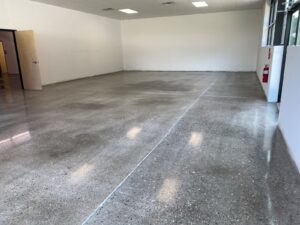When it comes to selecting residential polished concrete floors, you’re looking at one of the most durable, cost-effective, and environmentally friendly options available today. These floors are not only appealing for their aesthetic versatility but also for their longevity and minimal environmental impact, making them an ideal choice for eco-conscious architects, builders, and homeowners alike.
Polished concrete floors are gaining traction in residential design for good reasons. They provide an elegant, high-gloss finish that can be customized to fit any décor, all while offering the hardwearing and sustainable qualities that modern lifestyles demand. From the kitchen to the living room, and even outdoor patios, polished concrete is a versatile choice that meets a multitude of design and functional requirements.
Topcoat Services has been at the forefront of this trend, providing expert advice, installation, and finishing services that harness the full potential of polished concrete. With their focus on sustainability and durability, Topcoat Services can help you navigate the complexities of green building certifications, ensuring that your project not only looks stunning but also contributes positively to the environment.
Whether you’re an architect planning a sustainable housing project or a homeowner looking to upgrade your floors with a durable and eco-friendly option, this guide will offer everything you need to know about residential polished concrete floors.

Understanding Polished Concrete Floors
When it comes to upgrading your home with a flooring option that combines durability, aesthetics, and eco-friendliness, residential polished concrete floors stand out. Let’s break down what these floors are all about, from the basic definition to the detailed process of creating this stunning finish.
Definition
At its core, polished concrete is a flooring solution that transforms a basic concrete slab into a shiny, smooth, and attractive surface. This isn’t just about making the floor look glossy; it’s about enhancing the concrete’s natural strength and beauty through a meticulous process.
The Process
Creating a polished concrete floor involves a three-step process: grinding, honing, and polishing. Each step is crucial to achieving the final look and feel of the floor. Let’s explore these steps further.
- Grinding: This is the first step, where the top layer of the concrete is ground down with heavy-duty machines equipped with diamond-embedded pads. Think of it as sanding down a piece of wood, but on a much larger scale. The goal here is to smooth out the roughness, preparing the floor for further refinement.
- Honing: Next, the surface is honed to eliminate any visible marks from the grinding phase and to start bringing out the floor’s inherent beauty. This step uses finer grits, which begin to give the floor a polished appearance.
- Polishing: Finally, the magic happens during the polishing step. Using even finer grits, the floor develops that glossy, mirror-like finish everyone loves. This not only enhances the floor’s aesthetic appeal but also increases its resistance to staining and wear.
Throughout these steps, bonded abrasives play a vital role. These are the diamond pads or discs that do the hard work of cutting through the concrete, smoothing, and polishing it to perfection.
Why It Matters
Understanding the process behind polished concrete floors is crucial for several reasons:
- Durability: This process significantly enhances the concrete’s natural strength, making it even more durable and long-lasting.
- Aesthetics: Polished concrete floors offer a unique and sophisticated look that can complement any home style, from modern to rustic.
- Eco-Friendliness: The process is energy-efficient and uses existing materials (the concrete slab), reducing waste and minimizing environmental impact.
- Maintenance: Polished concrete floors are low maintenance, requiring only regular cleaning to keep them looking their best.
In summary, residential polished concrete floors are an excellent choice for homeowners seeking a durable, attractive, and eco-friendly flooring solution. Understanding the process of grinding, honing, and polishing helps appreciate the craftsmanship involved in creating these stunning floors. We’ll explore the numerous benefits that make polished concrete a superior flooring option.
Benefits of Polished Concrete Floors
When we talk about residential polished concrete floors, we’re talking about a flooring option that’s not just about looking good (though they do that exceptionally well). It’s about offering a range of benefits that cater to the needs of modern homeowners who are looking for durability, sustainability, and cost-effectiveness, all wrapped up in one. Let’s dive into these benefits:
Durability
Polished concrete floors are tough. They can handle heavy foot traffic, pets, spills, and everything in between. Unlike other flooring options that might scratch, dent, or need replacing after a few years, polished concrete stands the test of time. It’s not uncommon for these floors to last as long as the building itself!
Eco-Friendly
Choosing polished concrete is a win for the planet. These floors leverage the existing concrete slab, meaning there’s no need for additional materials that contribute to waste. Plus, their ability to reduce lifetime waste by up to 97% compared to other floors is a testament to their sustainability.
Cost-Effective
While the initial cost might seem high, polished concrete floors are an investment that pays off. Their longevity means you save money in the long run by avoiding the repair and replacement costs associated with other flooring types. Plus, their thermal mass can help cut down on energy bills, keeping your home cooler in the summer and warmer in the winter.
Aesthetics
Polished concrete floors offer a sleek, modern look that can be customized to fit any decor style. With options for different levels of sheen and the ability to add colors or designs, these floors can be as unique as you are. They also enhance the light in a room, making spaces feel brighter and more open.
Low Maintenance
Forget about special cleaners or constant upkeep. A simple sweep and occasional damp mop are all it takes to keep polished concrete floors looking their best. This ease of maintenance is a big plus for busy households.
Cleaner Air
Unlike carpets that can trap allergens and dust, polished concrete floors contribute to healthier indoor air quality. They don’t release volatile organic compounds (VOCs) into your home, making them a safer choice for families, especially those with allergies or pets.
Resistant to Mold
In damp environments, mold can be a real concern. But polished concrete floors are resistant to moisture and, therefore, less likely to harbor mold or mildew. This is especially beneficial in basements or bathrooms where moisture levels are higher.
Versatility in Design
Whether you’re after a high-gloss finish that reflects like a mirror or a matte finish for a more subdued look, polished concrete can be tailored to your preference. The ability to expose different levels of aggregate also adds to the design versatility, allowing for a range of textures and looks.
Light Reflectivity
The reflective properties of polished concrete can transform a space by enhancing natural light. This not only makes rooms feel more inviting but can also help reduce the need for artificial lighting, contributing further to energy savings.
In conclusion, residential polished concrete floors offer a blend of functionality, beauty, and sustainability that’s hard to match. They are a smart choice for homeowners who value durability, low maintenance, and eco-friendliness in their flooring options. As we transition into discussing the cost and installation process, it’s clear that polished concrete floors are not just a flooring choice but a long-term investment in the quality and comfort of your home.

Cost and Installation Process
When you’re thinking about getting residential polished concrete floors, the first questions that probably pop into your mind are about cost and how they’re installed. Let’s break it down, so you have a clear picture.
Pricing
The cost of polished concrete floors can seem like a puzzle, but it’s pretty straightforward once you get the hang of it. Generally, you’re looking at about $3 to $12 per square foot. This range varies based on a few things:
- The condition of your existing concrete
- The size of the area you’re covering
- The design and finish you choose
To put it in perspective, compared to other flooring options like hardwood or tile, which can cost anywhere from $6 to $22 per square foot, polished concrete is a wallet-friendly choice.
Square Footage
The size of your project matters. Larger areas typically cost less per square foot because it’s easier and more efficient to work on bigger, open spaces than smaller, tight ones.
Installation Steps
Installing polished concrete floors is an art. Here’s the simplified process:
- Grinding: The first step is to grind down the surface of the concrete to get rid of any imperfections.
- Honing: Next, the floor is honed with finer grits to start bringing out that shine.
- Polishing: Finally, even finer grits are used in the polishing step to achieve the desired level of gloss.
Aggregate Exposure Levels
The look of your polished concrete can vary based on how much of the aggregate (the bits of stone and sand in concrete) you want to show. There are three main types:
- Cream: Just a polish on the very top layer, giving a smooth and consistent finish.
- Salt and Pepper: A bit of the surface is ground away to reveal small bits of aggregate.
- Aggregate Exposed: More of the surface is removed to show more of the stone within the concrete.
Finishes
You’ve got options when it comes to the finish of your polished concrete:
- Matte: A low-gloss finish for a more subtle look.
- Low Gloss: A bit shinier than matte, but still not super reflective.
- High Sheen: This gives a bit of a glow to your floor but isn’t overly shiny.
- High Gloss: For that almost mirror-like finish.
Choosing the right finish and exposure depends on your personal style and the look you’re going for in your home. Whether you want something more natural and understated or a floor that makes a statement, there’s a polished concrete option for you.
In conclusion, the cost and process of installing polished concrete floors are influenced by several factors, including the size of your project, the existing condition of your concrete, and the finishes and exposure levels you choose. With their durability, low maintenance, and sleek aesthetic, polished concrete floors offer a cost-effective and stylish flooring solution for any home.
Let’s delve into how polished concrete compares to other flooring options, keeping in mind the unique benefits it brings to the table.
Comparing Polished Concrete to Other Flooring Options
When considering new flooring, weigh the pros and cons of each option. Let’s see how residential polished concrete floors stack up against hardwood, tile, laminate, and carpet.
Hardwood:
– Cost: Generally, hardwood floors can range from $11 to $25 per square foot, making them more expensive than polished concrete, which averages $3 to $12 per square foot.
– Durability: While hardwood floors offer a timeless look, they can be prone to scratches and water damage. Polished concrete, on the other hand, is highly durable and resistant to wear and tear.
– Maintenance: Hardwood requires regular cleaning and occasional refinishing. Polished concrete is low maintenance, needing only basic cleaning to keep its shine.
Tile:
– Cost: Tile flooring can cost between $10 and $50 per square foot, depending on the material. This makes it potentially more expensive than polished concrete.
– Durability: Tiles are durable and water-resistant but can crack under heavy impact. Polished concrete is equally durable but without the risk of cracking.
– Maintenance: Tile grout needs regular cleaning to prevent staining and mold growth. Polished concrete is easier to maintain, with no grout lines to worry about.
Laminate:
– Cost: Laminate flooring is a more affordable option, ranging from $2 to $10 per square foot. It’s comparable to the lower end of polished concrete pricing.
– Durability: Laminate is susceptible to water damage and can’t be refinished. Polished concrete floors are more durable and can last the lifetime of your home with proper care.
– Maintenance: Laminate requires regular cleaning and can be scratched or damaged more easily than polished concrete.
Carpet:
– Cost: Carpet is one of the most affordable options, with costs ranging from $2 to $8 per square foot. While initial costs may be lower, the need for replacement and professional cleaning can add up.
– Durability: Carpet wears down over time, especially in high-traffic areas, and can harbor allergens and dust. Polished concrete is more durable and allergen-free.
– Maintenance: Carpet requires vacuuming and periodic deep cleaning. Polished concrete is much simpler to maintain, needing only sweeping and mopping.
Cost Comparison, Durability, Maintenance
When comparing costs, it’s clear that polished concrete offers a competitive price point, especially when considering longevity and maintenance. Its durability surpasses that of hardwood, laminate, and carpet, making it a wise choice for areas with heavy foot traffic. Additionally, the maintenance of polished concrete is minimal, saving time and money over the life of the flooring.
In summary, residential polished concrete floors provide a cost-effective, durable, and low-maintenance flooring solution compared to traditional options like hardwood, tile, laminate, and carpet. Their versatility and aesthetic appeal make them an excellent choice for any home, offering both practical and stylish benefits.
Design and Customization Options
When we talk about residential polished concrete floors, we’re not just talking about a one-size-fits-all solution. This flooring option offers an array of design and customization options that can make your home truly stand out. Let’s dive into the possibilities.
Color Options
The beauty of polished concrete is that it doesn’t have to stay the gray color we often associate with concrete. Through coloring techniques such as acid staining or dyeing, you can transform your floors into almost any color you can imagine. Want a deep, rich blue for your living room? Or perhaps a vibrant red for your kitchen? It’s all possible with polished concrete.
Dyed Concrete
Dyed concrete goes a step further, offering even more vibrant color options. Unlike stains, which react chemically with the concrete, dyes penetrate the surface, providing more consistent color. This means you can achieve more intense and varied hues, perfect for creating a bold statement or matching your existing decor.
Design Flexibility
Polished concrete isn’t limited to solid colors. You can also incorporate geometric patterns, intricate designs, or even logos into your flooring. This is achieved by stenciling designs onto the floor before the polishing process. The result is a unique, customized look that can’t be replicated with other flooring types.
Enhancing with Rugs
Think polished concrete floors might be too stark for your taste? Rugs can add warmth, texture, and color, enhancing the overall aesthetic of your rooms. Plus, they can be easily changed out to update your decor or for seasonal variations.
Residential Spaces Best Suited
One of the best things about polished concrete is its versatility. It’s not just for industrial or commercial spaces; it’s perfect for just about any room in your home:
- Kitchens: Easy to clean and resistant to spills.
- Bathrooms: Water-resistant and can handle high humidity.
- Living Rooms: Sleek and modern, making a great impression.
- Bedrooms: Warm it up with rugs for a cozy feel.
- Basements: Ideal for areas prone to moisture.
- Patios: Durable against the elements.
- Garages: Tough enough for heavy use and easy to maintain.
Each space can benefit from the unique qualities of polished concrete, making it a comprehensive solution for your home.
In conclusion, the design and customization options for residential polished concrete floors are almost limitless. Whether you’re looking for a specific color, a unique design, or a practical solution for every room in your house, polished concrete offers the flexibility and durability to meet your needs. With the ability to enhance your space with rugs and the suitability for every room, polished concrete is not just a flooring option; it’s a lifestyle choice that reflects modern, sustainable living.

Addressing Common Concerns
When considering residential polished concrete floors, some common concerns might pop up. Let’s tackle these head-on:
Hardness
Yes, polished concrete is hard. That’s part of what makes it so durable. But, this doesn’t mean your home has to feel like a sidewalk. Area rugs can add a layer of softness where you need it most, like in living areas or bedrooms. Plus, the durability means it’s great for busy spaces that see a lot of foot traffic.
Coldness
Concrete can feel cold, especially in winter. However, this can be a plus in hot climates, where cool floors are a relief. In cooler areas, radiant heating can transform cold concrete into a cozy, warm surface. Another simple fix? Rugs and slippers can make a big difference.
Quality of Concrete Pour
The foundation of a great polished concrete floor is a high-quality concrete pour. This step is crucial. A smooth, well-leveled pour means a smoother polishing process and a better final look. Always ensure you’re working with experienced professionals who know how to pour concrete for polishing purposes.
Moisture Resistance
Polished concrete is generally resistant to moisture, especially when properly sealed. However, like any flooring, it’s not immune to water damage. Regular sealing and immediate clean-up of spills can keep your floors in top shape. For areas with high moisture, like basements, additional moisture barriers might be recommended.
Slip Resistance
Despite its shiny appearance, polished concrete can be surprisingly slip-resistant. The polishing process can be adjusted to add more or less texture to the floor, depending on your needs. For extra safety, especially in wet areas like kitchens and bathrooms, anti-slip conditioners can be applied.
In conclusion, while polished concrete floors come with a few considerations, each concern has a practical solution. With the right planning and care, residential polished concrete floors can be a durable, stylish, and comfortable flooring option that lasts for years. Moving forward, we’ll delve into the longevity and investment value of polished concrete, highlighting why Topcoat Services views it as a cornerstone of sustainable design.
Conclusion
When we talk about residential polished concrete floors, we’re not just discussing a trendy flooring option. We’re talking about a long-term investment in your home’s future. Let’s break down why this choice is so compelling, focusing on longevity, investment value, and our commitment to sustainable design at Topcoat Services.
Longevity
One of the most striking benefits of polished concrete is its ability to stand the test of time. With a lifespan extending decades—often outlasting the very buildings they’re installed in—polished concrete floors are a testament to durability. This isn’t just about enduring wear and tear; it’s about maintaining their beauty and functionality year after year. Regular, simple maintenance can keep these floors looking as good as new, far longer than many alternatives.
Investment Value
Choosing polished concrete isn’t just a decision for today—it’s an investment in your property’s value for years to come. Not only does it reduce the need for frequent replacements or repairs, but it also adds a modern, high-quality aesthetic that can appeal to future buyers. The cost-effectiveness of polished concrete, when considered over the long term, is unmatched. You’re not just saving on initial costs but also on maintenance, repair, and energy bills, thanks to its thermal mass and light-reflective properties.
Topcoat Services Focus on Sustainable Design
At Topcoat Services, our passion for sustainable design drives us. Polished concrete floors embody this commitment perfectly. They leverage existing materials, minimize waste, and reduce the need for chemical cleaners. Their high reflectivity can lower lighting needs, saving energy. Additionally, the thermal mass of concrete helps regulate indoor temperatures, cutting down on heating and cooling demands.
Our approach is about more than just installing a floor. It’s about crafting a solution that aligns with your values and our planet’s needs. We believe in educating and guiding our clients through the myriad of possibilities polished concrete offers. Whether you’re looking for a simple, elegant finish or something with intricate designs and colors, we’re here to bring your vision to life in the most sustainable way possible.
Choosing residential polished concrete floors is choosing a future where design, durability, and sustainability meet. It’s an investment not just in your home, but in a better world. At Topcoat Services, we’re ready to help you make that choice, ensuring your flooring is not just beautiful but beneficial to the planet.
Explore how we can transform your space with sustainable, stylish, and durable flooring solutions. Visit us at Topcoat Services for more on our residential flooring solutions.









